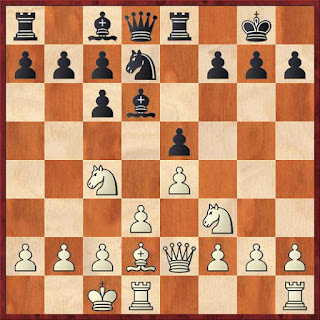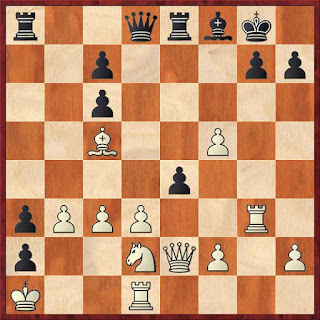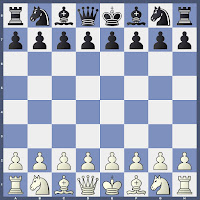Pawn rush....Candidates: Round - 8
"No two persons ever read the same book" - Edmund Wilson
Chess players are letting manifest ideas on how they interpret their moves in consonance...correlation with opponents moves!
And this interpretation is the result of how they read and understood chess, primarily! As a book is read and understood differently by different person - why even by the same person at different times - so is chess principles understood and followed by different players and even the same player at different times!
....in short.....we evolve....keep evolving eternally!
The only aspect which can put an end to this process of eternal evolution is the thought that one has 'arrived'....'understood'.....which prevents one from exploring and experimenting.
Experiment and exploration are the prerequisites for rising higher in terms of perceiving something and keep progressing to the ever eluding ultimate truth....!
We do not seek to arrive at a finite knowledge, finite truth.....for, as in life, so in chess we know not if it really exists and assuming it does, it will always fall short of our reach and comprehension!
In his fine book "Modern moments in chess", Reuben Fine wrote about "perfect Chess" thus, "....in chess, the quest for perfection is full of pitfalls and paradoxes....the mistakes justifies the existence of chess. Grandmasters abandon a game, either as a draw or by resigning, much sooner than amateurs because they regard the probability of another mistake as extremely small. In fact, we can say, paradoxically, that if both sides play perfect chess ceases to be a passionate struggle and becomes a cold mathematical exercise."
In the first round of the second leg of Candidates, Hikaru in desperation, tries an experiment, in response to Caruana's different approach in the sedate opening....
Fabiano Caruana - Hikaru Nakamura, Candidates - 2016
With his castling on the Queen side, Caruana declared his intentions to pile up pressure on Black's King and its protectors.
10.....b5?!
The problem in hand for Black is that, a similar attempt on White's King, which has found a safe haven on the Queenside, is not so harmonious....and ominous.
The chief problem that he encounters is the positioning of his minor pieces and his inability to stage a timely counter on the center so as to weaken White's intentions and to provide lines and outpost for his pieces for counter attack.
This move only aids the Knight to go a square where he intends to!
11.Ne3 a5; 12.Nf5 a4; 13.Bg5!
A nice move which is aimed at provoking Black to commit a weak pawn push, which will come in handy for the ensuing pawn storm! Obviously, Black is not obliged to obey White's intention....but he does!
13.....f6?
Of course, 13...Nf6 was necessary; which does not weaken his King's fortress and allows the Bishop on c8 to get some fresh air and threaten to capture that imposing Knight on f5. And if White plays, N3h4 to reinforce that Knight, Black can push .....h6 and ask some pivotal questions to White.
Also, you can put the light squared Bishop on e6 and start thinking of counter action on White's King at an opportune moment.
It is easy to criticise anything on hindsight!
But, sitting on the Black side of the board, you cannot rule out thinking seriously about playing 13.....f6!? What looks like a mistake from outside and on the hindsight, may not appear so during the thick of action. For the move secures the e5 pawn permanently and frees the Knight which was hitherto defending it to go and participate on the Queenside offensive. It also frees way for the development of the .....c8 Bishop and in some cases, the Knight can also land on the nice e6 square, secured by his pawns, from where it will forestall the push d4 by White, whilst having an eye on the g7 and g5 squares which will come under attack as and when White pushes his pawns and puts his piece on the g-file.
14.Be3! Nc5; 15.g4 Be6; 16.Kb1 b4; 17.g5 b3!?
After having put your feet on the bridge, it is only logical to try and cross over, come what may.
Both sides have carried out their intended pawn push to breach the fortress of the respective Kings. The difference is that Black had provided a target for White with his 13th move, whilst White has absolutely no pawn weakness in front of his King.
Such a motif is common in Sicilian defence and one that comes to mind is the fine game which Sanakoev played against Maeder (vice versa!? or both!!) in the correspondence World Championship finals in 1979-84.
Sanakoev - Maeder
Here, Maeder played an outlandish 24.....b3!!? putting the pawn on a square where it could be captured in three different ways and Sanakoev wrote and substantiated, in his great book, that all the three had their drawbacks!
White played 25.Rh3!? allowing this audacious pawn to reach a2 - a step away from turning into a new Queen - as Black King was precariously placed and the Knight on g7 is a poor defender of the squares immediately around it! 25.....ba2; 26.Qh7 Kf8; 27.Qh8 Ke7; 28.Qh4 f6!
....and the play went on in aggressive fashion with both sides succeeding in holing-out the respective Kings into the open and Black won a nice game after a protracted struggle.
Sanakoev wrote thus: "I have played about 300 games by correspondence and won the majority of them, but few of those victories have given me so much creative satisfaction as this unsuccessful attack. The excitement of the imaginative contest took such a hold of me that at a certain point the bare result ceased to be all that important; creativity occupied the foreground. Perhaps that is why I remember this game even today, whereas dozens of wins were forgotten the moment I sent the scoresheet off to the controller."
Hikaru's ....b3 wasn't similar to the one seen above, despite reaching 'a2' square, for..... Caruana's King found the safest haven under its cover!
18.Rhg1 ba2; 19.Ka1!
At times, even your own pawn cannot defend your King as well as your opponent's.....as in the present case!
19....Bf5; 20.ef5 a3
Perhaps, Nakamura banked on this move. Now, obviously, White cannot allow this pawn to reach b2....but.....!
21.b3!
This push can be carried out with impunity, since White neither has a light squared Bishop to exert pressure, nor can exploit the weakened dark squares as White has sufficient resources to cover that diagonal with his pawn and control it with pieces, without lessening the intensity of attack against Black's King.
21....Na6?!
Probably it is time Black starts thinking about defence than trying this obstinate offence. Thoughts about tucking the King in the corner like White did, followed by deploying this Knight to the defence of f6 square and if need be, put a Rook behind his g-pawn etc should be entertained.
22.c3! Bf8; 23.Nd2 fg5; 24.Rg5 Nc5; 25.Rg3 e4; 26.Bc5!
This removes Black's only active piece and decides the outcome!
26.....Bc5; 27.Ne4 Bd6; 28.Rh3 Be5; 29.d4! Bf6; 30.Rg1 Rb8; 31.Ka2!
The King bid adieu to this enemy pawn, profusely thanking it!
31.....Bh4; 32.Rg4 Qd5; 33.c4! 1 - 0
It is easy to be critical of Black's play....but only would realise the difficulty only when they sit in front of the board, with so much at stake.....and with the sort of form Hikaru finds himself in......
......especially after that.......




.jpg)
.jpg)

Comments
Post a Comment